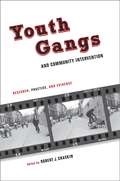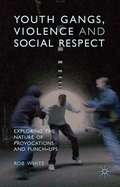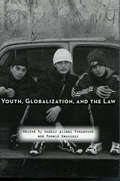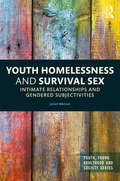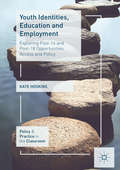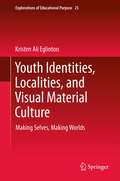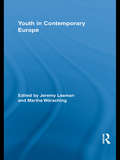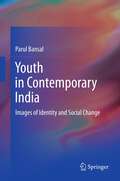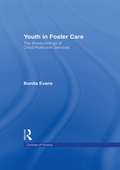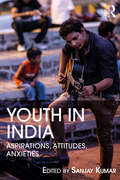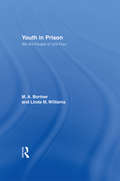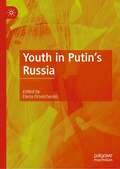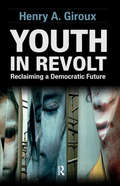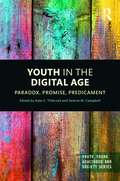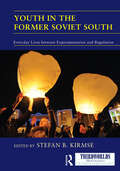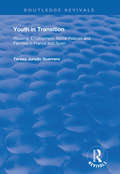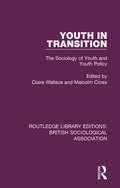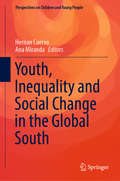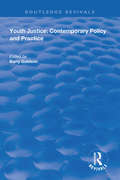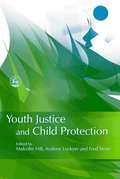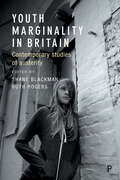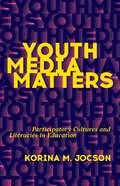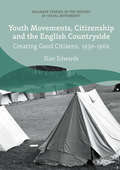- Table View
- List View
Youth Gangs and Community Intervention: Research, Practice, and Evidence
by Chaskin Robert J. Ed.Although a range of program and policy responses to youth gangs exist, most are largely based on suppression, implemented by the police or other criminal justice agencies. Less attention and fewer resources have been directed to prevention and intervention strategies that draw on the participation of community organizations, schools, and social service agencies in the neighborhoods in which gangs operate. Also underemphasized is the importance of integrating such approaches at the local level. In this volume, leading researchers discuss effective intervention among youth gangs, focusing on the ideas behind, approaches to, and evidence about the effectiveness of community-based, youth gang interventions. Treating community as a crucial unit of analysis and action, these essays reorient our understanding of gangs and the measures undertaken to defeat them. They emphasize the importance of community, both as a context that shapes opportunity and as a resource that promotes positive youth engagement. Covering key themes and debates, this book explores the role of social capital and collective efficacy in informing youth gang intervention and evaluation, the importance of focusing on youth development within the context of community opportunities and pressures, and the possibilities of better linking research, policy, and practice when responding to youth gangs, among other critical issues.
Youth Gangs, Violence and Social Respect
by Rob WhiteThis is the first book dedicated to Australian youth gangs, exploring the subtleties and nuances of street life for young men and their quest for social respect. It focuses specifically on group violence and the ways in which the 'gang' provides a forum for the expression of this violence. White argues that what happens on the street demands a holistic analysis which takes into account the interrelationships between class circumstance, masculinity, race and ethnicity. Gangs and gang violence are thus 'made' in the crucible of specific histories, specific neighbourhoods and specific social contexts. Based upon many years of research, and drawing upon the theoretical insights of international literature in this area, this book provides a sustained analysis and portrayal of youthviolence and youth gangs – one that includes and highlights the voices and viewpoints of the young people themselves.
Youth, Globalization, and the Law
by Sudhir Venkatesh Ronald KassimirThis book addresses the impact of globalization on the lives of youth, focusing on the role of legal institutions and discourses. As practices and ideas travel the globe--such as the promotion and transmission of zero tolerance and retributive justice programs, the near ubiquitous acceptance of the UN Convention on the Rights of the Child, and the transnational migration of street gangs--the legal arena is being transformed. The essays in this book offer case studies and in-depth analyses, spanning diverse settings including courts and prisons, inner-city streets, international human rights initiatives, newspaper offices, local youth organizations, and the United Nations. Drawing on everyday social practices, each chapter adds clarity to our current understanding of the ways in which ideas and practices in different parts of the world can affect youth in one particular locale.
Youth Homelessness and Survival Sex: Intimate Relationships and Gendered Subjectivities (Youth, Young Adulthood and Society)
by Juliet WatsonSurvival sex, commonly understood to be the exchange of sex for material support, is a practice that is associated with young homeless women. However, such a narrow definition of survival sex fails to recognise the multiple, complex, and coexisting motivations of young homeless women for engaging in intimate relationships in post-industrial capitalist society. In Youth Homelessness and Survival Sex, Watson’s insightful analysis of personal narratives reveals how young homeless women are exposed to situations in which survival can be impeded or assisted by playing out specific gender roles. Indeed, in identifying and contesting the dominant social discourses that young homeless women draw upon to frame their experiences of intimate affairs, Watson challenges the reader to understand how gendered subjectivities are produced and performed through heteronormative relationships. This enlightening book is vital in showing that homelessness is not a gender-neutral phenomenon and that there are gender-specific processes and practices involved in the navigation of poverty, violence, and social exclusion. Youth Homelessness and Survival Sex will appeal to undergraduate and postgraduate students, as well as postdoctoral researchers, interested in fields such as Homelessness, Youth Studies, Social Work, and Gender Studies.
Youth Identities and Argentine Popular Music
by Pablo Semán Pablo VilaThis book analyzes the music that young porte#65533;as/os (the inhabitants of Buenos Aires, Argentina) actually listen to nowadays, which, contrary to well-entrenched stereotypes, is not tango but rock nacional, cumbiaand romantic music. Chapters examine the music and what the Argentinean youth use it to say about themselves.
Youth Identities, Education and Employment
by Kate HoskinsThis book investigates how policy, family background, social class, gender and ethnicity influence young people's post-16 and post-18 employment and education access. It draws on existing literature, alongside new data gathered from a case study in a UK state secondary school, to examine how policy changes to the financial arrangements for further and higher education and the changing youth employment landscape have had an impact on young people's choices and pathways. Hoskins explores a number of topics, including the role of identity in young people's decision-making; the impact of changes to young people's financial arrangements, such as cuts to the Education Maintenance Allowance and increased university fees; and the influence of support from parents and teachers. The book will be of interest to students and researchers of Education and Sociology.
Youth Identities, Localities, and Visual Material Culture
by Kristen Ali EglintonThis invaluable addition to Springer's Explorations of Educational Purpose series is a revelatory ethnographic account of the visual material culture of contemporary youths in North America. The author's detailed study follows apparently dissimilar groups (black and Latino/a in a New York City after-school club, and white and Indigenous in a small Canadian community) as they inflect their nascent identities with a sophisticated sense of visual material culture in today's globalized world. It provides detailed proof of how much ethnography can add to what we know about young people's development, in addition to its potential as a model to explore new and significant avenues in pedagogy. Supported by a wealth of ethnographic evidence, the analysis tracks its subjects' responses to strikingly diverse material ranging from autobiographical accounts by rap artists to the built environment. It shows how young people from the world's cultural epicenter, just like their counterparts in the sub-Arctic, construct racial, geographic and gender identities in ways that are subtly responsive to what they see around them, blending localized characteristics with more widely shared visual references that are now universally accessible through the Web. The work makes a persuasive case that youthful engagement with visual material culture is a relational and productive activity that is simultaneously local and global, at once constrained and enhanced by geography, and possesses a potent and life-affirming authenticity. Densely interwoven with young people's perspectives, the author's account sets out an innovative and interdisciplinary conceptual framework affording fresh insights into how today's youth assimilate what they perceive to be significant. Supported by a wealth of ethnographic evidence, the analysis tracks its subjects' responses to strikingly diverse material ranging from autobiographical accounts by rap artists to the built environment. It shows how young people from the world's cultural epicenter, just like their counterparts in the sub-Arctic, construct racial, geographic and gender identities in ways that are subtly responsive to what they see around them, blending localized characteristics with more widely shared visual references that are now universally accessible through the Web. The work makes a persuasive case that youthful engagement with visual material culture is a relational and productive activity that is simultaneously local and global, at once constrained and enhanced by geography, and possesses a potent and life-affirming authenticity. Densely interwoven with young people's perspectives, the author's account sets out an innovative and interdisciplinary conceptual framework affording fresh insights into how today's youth assimilate what they perceive to be significant. Supported by a wealth of ethnographic evidence, the analysis tracks its subjects' responses to strikingly diverse material ranging from autobiographical accounts by rap artists to the built environment. It shows how young people from the world's cultural epicenter, just like their counterparts in the sub-Arctic, construct racial, geographic and gender identities in ways that are subtly responsive to what they see around them, blending localized characteristics with more widely shared visual references that are now universally accessible through the Web. The work makes a persuasive case that youthful engagement with visual material culture is a relational and productive activity that is simultaneously local and global, at once constrained and enhanced by geography, and possesses a potent and life-affirming authenticity. Densely interwoven with young people's perspectives, the author's account sets out an innovative and interdisciplinary conceptual framework affording fresh insights into how today's youth assimilate what they perceive to be significant.
Youth in Contemporary Europe (Routledge Advances in Sociology)
by Jeremy LeamanThis book examines the everyday living conditions experienced and also shaped by young people in Europe. Contributors reflect on the current context of economic, social and political change affecting youth in the critical transition from dependence to independence. The volume provides the reader with a multi-dimensional and interdisciplinary view of youth cultures, drawn from a variety of recent research throughout the continent.
Youth in Contemporary India
by Parul BansalThis book endeavors to be a study of identity in Indian urban youth. It is concerned with understanding the psychological themes of conformity, rebellion, individuation, relatedness, initiative and ideological values which pervade youths' search for identity within the Indian cultural milieu, specifically the Indian family. In its essence, the book attempts to explore how in contemporary India the emerging sense of individuality in youth is seeking its own balance of relationality with parental figures and cohesion with social order. The research questions are addressed to two groups of young men and women in the age group of 20-29 years-Youth in Corporate sector and Youth in Non Profit sector. Methodologically, the study is a psychoanalytically informed, process oriented, context sensitive work that proceeds via narrations, conversations and in-depth life stories of young men and women. Overall, the text reflects on the nature of inter-generational continuity and shifts in India.
Youth in Foster Care: The Shortcomings of Child Protection Services (Children of Poverty)
by Bonita EvansFirst published in 1998. Routledge is an imprint of Taylor & Francis, an informa company.
Youth in India: Aspirations, Attitudes, Anxieties
by Sanjay KumarThis book explores the attitudes, anxieties and aspirations of India’s burgeoning young population in a globalised world. Drawing upon time-series survey data of the Indian youth aged between 15 and 34 years across 19 Indian states, it provides key insights into a range of themes along with an overview of the changing trends and patterns of their behaviour. The volume examines the job preferences of the Indian youth, their career priorities and opinions on reservations in employment and education sectors. It measures their degree of political participation and studies their attitude regarding political issues. It looks at aspects relating to their social and cultural contexts, preferences and practices, including lifestyle choices, consumption habits and social customs such as marriage, as they negotiate between tradition and modernity. Further, it discusses the anxieties and insecurities that the youth face, their mental health and their experiences of social discrimination. The essays here offer an understanding of a critical demographic and shed light on the challenges and opportunities that the Indian youth confront today. Lucid, accessible and empirically grounded, this volume will be useful to scholars and researchers of sociology, political sociology, political studies, youth psychology and anthropology as well as policymakers, journalists and the interested general reader.
Youth in Prison: We the People of Unit Four
by M. A. Bortner Linda WilliamsBased on two years of intensive research in a juvenile prison, this study tells the story of youths in a "model program," created after a class action lawsuit for inhumane and illegal practices. It captures their lives inside and outside of prison: from drugs, gangs and criminal behaviour to the realities of families, schools and neighbourhoods. Drawing on experience that encompasses 20 years of juvenile justice research and policy analysis, the authors scrutinize the prison's attempts to combine accountability and treatment for youths with protection for the public, situating these within the larger social and political context.
Youth in Putin's Russia
by Elena OmelchenkoThis edited volume sheds light on the lives of young people in various central and peripheral regions of Russia, including youth belonging to different ethnic and religious groups and who have differing views on contemporary politics. While the literature continues to grow regarding the inclusion of youth in global contexts, the specific cultural, political, and economic circumstances of being young in Russia make the Russian case unique. Chapter authors focus on four key aspects that characterize the youth experience in contemporary Russia: cultural practices and value affiliations, citizenship and patriotism, ethnic and religious diversity, and the labor market. This collection will appeal to readers interested in contemporary life in Russia and looking for the latest empirical material on youth identities and cultures, as well as those looking to learn about the critical viewpoint of local academics regarding the ongoing processes in contemporary Russian society.
Youth in Revolt: Reclaiming a Democratic Future (Critical Interventions)
by Henry A. GirouxRecently, American youth have demonstrated en masse about a variety of issues ranging from economic injustice and massive inequality to drastic cuts in education and public services. Youth in Revolt chronicles the escalating backlash against dissent and peaceful protest while exposing a lack of governmental concern for society's most vulnerable populations. Henry Giroux carefully documents a wide range of phenomena, from pervasive violent imagery in our popular culture to educational racism, censorship, and the growing economic inequality we face. He challenges the reader to consider the hope for democratic renewal embodied by Occupy Wall Street and other emerging movements. Encouraging a capacity for critical thought, compassion, and informed judgment, Giroux's analysis allows us to rethink the very nature of what democracy means and what it might look like in the United States and beyond.
Youth in the Digital Age: Paradox, Promise, Predicament (Youth, Young Adulthood and Society)
by Kate C Tilleczek Valerie M CampbellYoung people spend a significant amount of time with technology, particularly digital and social media. How do they experience and cope with the many influences of digital media in their lives? What are the main challenges and opportunities they navigate in living online? Youth in the Digital Age provides answers from a decidedly interdisciplinary perspective, beginning in a framework steeped in context; biography; and societal influences on young people, who now make up 25% of the earth’s population. Placing these perspectives alongside those of current scholars and commentators to help analyse what young people are up against in navigating the digital age, the volume also draws on data from a five-year research project (Digital Media and Young Lives). Topics explored include well-being, privacy, control, surveillance, digital capital, and social relationships. Based on unique and emergent research from Canada, Scotland, and Australia, Youth in the Digital Age will appeal to post-secondary educators and scholars interested in fields such as youth studies, education, media studies, mental health, and technology.
Youth in the Former Soviet South: Everyday Lives between Experimentation and Regulation (ISSN)
by Stefan B. KirmseThis book offers the first comprehensive analysis of youth, in all its diversity, in Muslim Central Asia and the Caucasus. It brings together a range of academic perspectives, including media studies, Islamic studies, the sociology of youth, and social anthropology. While most discussions of youth in the former Soviet South frame the younger generation as victims of crisis, as targets of state policy, or as holy warriors, this book maps out the complexity and variance of everyday lives under post-Soviet conditions. Youth is not a clear-cut, predictable life stage. Yet, across the region, young people’s lives show forms of experimentation and regulation. Male and female youth explore new opportunities not only in the buzzing space of the city, but also in the more closely monitored neighbourhood of their family homes. At the same time, they are constrained by communal expectations, ethnic affiliation, urban or rural background and by gender and sexuality. While young people are more dependent and monitored than many others, they are also more eager to explore and challenge. In many ways, they stand at the cutting edge of globalization and post-Soviet change, and thus they offer innovative perspectives on these processes. This book was published as a special issue of Central Asian Survey.
Youth in the Roman Empire
by Christian Laes Johan StrubbeModern society has a negative view of youth as a period of storm and stress, but at the same time cherishes the idea of eternal youth. How does this compare with ancient Roman society? Did a phase of youth exist there with its own characteristics? How was youth appreciated? This book studies the lives and the image of youngsters (around 15-25 years of age) in the Latin West and the Greek East in the Roman period. Boys and girls of all social classes come to the fore; their lives, public and private, are sketched with the help of a range of textual and documentary sources, while the authors also employ the results of recent neuropsychological research. The result is a highly readable and wide-ranging account of how the crucial transition between childhood and adulthood operated in the Roman world.
Youth in Transition: Housing, Employment, Social Policies and Families in France and Spain (Routledge Revivals)
by Teresa Jurado GuerreroThis title was first published in 2002: In recent years there has been a trend among young people across Europe towards remaining longer in their parental homes. Many reasons have been suggested for this change in demographic patterns, but Teresa Jurado Guerrero’s study of France and Spain represents the first in-depth cross-national analysis of this important social and economic issue. The book provides systematic comparisons of living arrangements at cross-national, cross-regional and individual levels and examines the results of two large-scale national surveys. It investigates the relevance of young people’s employment situations, social policies related to youth, national and regional housing markets and family norms, and identifies policy measures which would encourage early home-leaving and family formation. The book exposes the existence and effects of different national and individual strategies surrounding the process of becoming socially independent, and offers unique insights into an issue of key relevance for parents, young people, researchers and policy makers.
Youth in Transition: The Sociology of Youth and Youth Policy (Routledge Library Editions: British Sociological Association #6)
by Claire Wallace Malcolm CrossOriginally published in 1990, Youth in Transition addresses the issue of large-scale policy intervention, related to problems of employment in Britain’s youth. The book reflects the changes within sociology from studying youth as self-contained instigators of change, to examining the role they have come to play as the target of official, rather than popular or media attention. Changes in youth experience are affecting family relations and dependence or creating homelessness, regional economic disparities, demographic changes and training and employment opportunities, present a new model of youth and re-define its status. The book brings together original work in the field of youth and youth policy in the ‘80s and ‘90s.
Youth, Inequality and Social Change in the Global South (Perspectives on Children and Young People #6)
by Hernan Cuervo Ana MirandaThis book gathers international and interdisciplinary work on youth studies from the Global South, exploring issues such as continuity and change in youth transitions from education to work; contemporary debates on the impact of mobility, marginalization and violence on young lives; how digital technologies shape youth experiences; and how different institutions, cultures and structures generate a diversity of experiences of what it means to be young. The book is divided into four broad thematic sections: (a) Education, work and social structure; (b) Identity and belonging; (c) Place, mobilities and marginalization; and (d) Power, social conflict and new forms of political participation of youth.
Youth Justice: Contemporary Policy and Practice (Routledge Revivals)
by Barry GoldsonPublished in 1999, the aim of this text is to offer a critical analysis of contemporary policy and practice in relation to children and crime. It provides an integrated edited text combining a critical commentary of contemporary social/criminal justice policy with analyses of progressive practice in the UK. It offers coverage of each discrete stage in the processing of "child offenders" in the criminal justice system. It develops an alternative policy and practice framework drawing on experience from the UK, Europe, the USA, Canada, Australia and New Zealand.
Youth Justice and Child Protection
by Malcolm Hill Andrew Lockyer Fred StoneThis book is an examination of recent developments in the areas of youth justice and child protection. It investigates how well young people and the societies in which they live are served by judicial and service systems. Consideration is given to those in care - in young offenders' institutions, foster families and residential homes - as well as those living with their families. A broad range of international experts discuss the largely segregated youth justice and children's legal and service systems in England and Wales, other parts of Western Europe and the US, and compare these with Scotland's integrated system. The implications of these arrangements are considered for the rights of children and parents on the one hand and society on the other. The contributors also provide insights into the rationale for current and proposed policies, as well as the efficacy of different systems. This book will be an important reference for policy-makers, social workers, lawyers, magistrates and equivalent decision makers, health professionals, carers, and all those working in youth justice and child protection. It is highly relevant for academics and students interested in children, citizenship, youth crime, child welfare and state-family relations.
Youth Marginality in Britain: Contemporary Studies of Austerity
by Shane Blackman and Ruth RogersTabloid headlines such as ‘Anti-social Feral Youth,’ ‘Vile Products of Welfare in the UK’ and ‘One in Four Adolescents is a Criminal’ have in recent years obscured understanding of what social justice means for young people and how they experience it. Youth marginality in Britain offers a new perspective by promoting young people’s voices and understanding the agency behind their actions. It explores different forms of social marginalisation within media, culture and society, focusing on how young people experience social discrimination at a personal and collective level. This collection from a wide range of expert contributors showcases contemporary research on multiple youth deprivation of personal isolation, social hardship, gender and ethnic discrimination and social stigma. With a foreword from Robert MacDonald, it explores the intersection of race, gender, class, asylum seeker status and care leavers in Britain, placing them in the broader context of austerity, poverty and inequality to highlight both change and continuity within young people’s social and cultural identities. This timely contribution to debates concerning youth austerity in Britain is suitable for students across youth studies, sociology, education, criminology, youth work and social policy.
Youth Media Matters: Participatory Cultures and Literacies in Education
by Korina M. JocsonIn an information age of youth social movements, Youth Media Matters examines how young people are using new media technologies to tell stories about themselves and their social worlds. They do so through joint efforts in a range of educational settings and media environments, including high school classrooms, youth media organizations, and social media sites. Korina M. Jocson draws on various theories to show how educators can harness the power of youth media to provide new opportunities for meaningful learning and “do-it-together production.” Describing the impact that youth media can have on the broader culture, Jocson demonstrates how it supports expansive literacy practices and promotes civic engagement, particularly among historically marginalized youth.In Youth Media Matters, Jocson offers a connective analysis of content area classrooms, career and technical education, literary and media arts organizations, community television stations, and colleges and universities. She provides examples of youth media work—including videos, television broadcasts, websites, and blogs—produced in the San Francisco Bay Area, Los Angeles, New York, and St. Louis. At a time when educators are increasingly attentive to participatory cultures yet constrained by top-down pedagogical requirements, Jocson highlights the knowledge production and transformative potential of youth media with import both in and out of the classroom.
Youth Movements, Citizenship and the English Countryside: Creating Good Citizens, 1930-1960 (Palgrave Studies in the History of Social Movements)
by Sian EdwardsThis book explores the significance and meaning of the countryside within mid-twentieth century youth movements. It examines the ways in which the Boy Scouts, Girl Guides, Woodcraft Folk and Young Farmers' Club organisations employed the countryside as a space within which 'good citizenship' - in leisure, work, the home and the community - could be developed. Mid-century youth movements identified the 'problem' of modern youth as a predominantly urban and working class issue. They held that the countryside offered an effective antidote to these problems: being a 'good citizen' within this context necessitated a respectful and mutually beneficial relationship with the rural sphere. Avenues to good citizenship could be found through an enthusiasm for outdoor recreation, the stewardship of the countryside and work on the land. However, models of good citizenship were intrinsically gendered.
